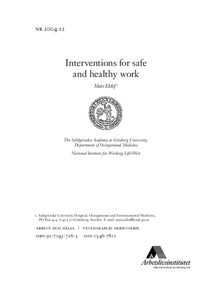Interventions for safe and healthy work
"The general aim of this thesis was to contribute to the research-based knowledge about 1) individual psychological and social factors that may influence activity to modify the working environment, 2) general characteristics of how working-environment change processes are organized and their as...
| Main Author: | |
|---|---|
| Institution: | ETUI-European Trade Union Institute |
| Format: | TEXT |
| Language: | English |
| Published: |
Stockholm
2004
NIWL |
| Subjects: | |
| Online Access: | https://www.labourline.org/KENTIKA-19138312124919565949-interventions-for-safe-and-hea.htm |
| Summary: | "The general aim of this thesis was to contribute to the research-based knowledge about 1) individual psychological and social factors that may influence activity to modify the working environment, 2) general characteristics of how working-environment change processes are organized and their associations with working-environment and health, and 3) interventions designed to stimulate activity to modify the working environment and their effects in terms of activity, working-environment and health. The thesis is based on five studies:
Study I
Aim: Explore associations between psychological and social factors, respectively, and activity in safety work, among Swedish fishermen.
Method: Cross-sectional questionnaire study (n=92).
Results: Correlation and regression analyses indicated that the perceived manageability of risks was positively associated with activity in safety work. Association with activity in safety work could not be demonstrated for injury/near-injury event experience, perceived personal risk, risk acceptance, fatalism, or general technical competence.
Conclusion: The results are in discord with other research in fishery that has claimed risk acceptance and fatalism to be associated with low activity in safety work.
Study II
Aim: To test a group-based intervention method for increased activity in safety work among Swedish fishermen: Feasibility, process and results in terms of activity in safety work and perceived manageability of risks.
Method: Structured documentation and analysis of injury/near-injury events. Group discussions about possible preventive measures. Technical expert support available. Case study, process study. Observational, interview, and longitudinal questionnaire data (n=11).
Results: Participative, talk-based safety interventions were feasible. Structured documentation and discussions made safety problems but also difficulties associated with preventive work more explicit. Effective cooperation between participants and technical experts seemed beneficial in order to stimulate preventive activity.
Conclusion: Issues related to manageability should be given more attention in this kind of intervention. Technical expert support concerning ways to manage identified risks valuable.
Study III
Aim: To study associations between degree of worker participation in working-environment change processes, and integration of quality/productivity/organization issues and working-environment issues, on the one hand, and working-environment and health outcomes, on the other.
Method: Swedish white-collar VDU-users (n=399). Questionnaire data from two points in time. Correlation analyses.
Results: Higher degrees of worker participation and integration were associated with lower psychological job demands, higher social support, and less stress. With decision latitude, musculoskeletal complaints, comfort during work and quality of modifications in the working environment, associations were weaker and less reliable.
Conclusion: The results suggested that participation and integration were not strong independent predictors for more positive working-environment conditions generally.
Studies IV and V
Aim: Study effects from feedback of data concerning workplace design, working technique, psychosocial factors, and musculoskeletal symptoms. Outcomes: activity to modify the working environment, quality of modifications, psychosocial factors, comfort during VDU-work, emotional stress, and musculoskeletal symptoms.
Method: Cluster randomized controlled study among Swedish white collar VDU-users (n(groups)=36). Three feedback variants: To individual workers, to group supervisors individually, or to entire workgroups including supervisor. A simple one session feedback method was used. Ergonomist performed the intervention.
Results: Positive effect with respect to activity to modify workplace design and working technique in all feedback variants. Positive effect with respect to activity to modify psychosocial aspects, and social support, in feedback to supervisor condition.
Conclusion: Effects on modification activity and social support were observed in a randomized controlled feedback intervention study among Swedish VDU-users. Feedback to supervisors appeared as the most cost-effective feedback variant." |
|---|---|
| Physical Description: | 69 p. Digital |

